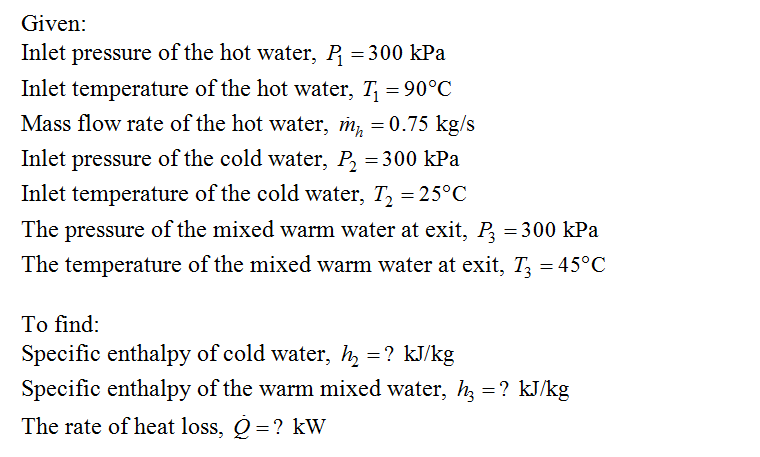A hot-water stream at 90 °C enters an insulated mixing chamber with a mass flow rate of mh=0.75 kg/s where it is mixed with a stream of cold water at 25°C in a steady state steady flow process. It is desired that the mixture leaves the chamber at 45°C as shown in the Figure Hot water P₁=300 kPa T₁=90°C m=0.75 kg/s Cold water P-300 kPa T₁=25% m=? 1 2 Mixing Chamber Mixed warm wate P-300 kPa T=45°C m3
A hot-water stream at 90 °C enters an insulated mixing chamber with a mass flow rate of mh=0.75 kg/s where it is mixed with a stream of cold water at 25°C in a steady state steady flow process. It is desired that the mixture leaves the chamber at 45°C as shown in the Figure Hot water P₁=300 kPa T₁=90°C m=0.75 kg/s Cold water P-300 kPa T₁=25% m=? 1 2 Mixing Chamber Mixed warm wate P-300 kPa T=45°C m3
Elements Of Electromagnetics
7th Edition
ISBN:9780190698614
Author:Sadiku, Matthew N. O.
Publisher:Sadiku, Matthew N. O.
ChapterMA: Math Assessment
Section: Chapter Questions
Problem 1.1MA
Related questions
Question
![**Question 2**
The specific enthalpy of the cold water, h2, in kJ/kg is
[Text Box]
---
**Question 3**
The specific enthalpy of the warm mixed water, h3, in kJ/kg is
[Text Box]
---
**Question 4**
The rate of heat loss in kW is
[Text Box]](/v2/_next/image?url=https%3A%2F%2Fcontent.bartleby.com%2Fqna-images%2Fquestion%2F0caa681c-a86e-42ac-a3af-b6c8d3fe3f57%2Fa407b2ad-843c-4eee-a83c-9f1468a27d07%2F9hudkqh_processed.jpeg&w=3840&q=75)
Transcribed Image Text:**Question 2**
The specific enthalpy of the cold water, h2, in kJ/kg is
[Text Box]
---
**Question 3**
The specific enthalpy of the warm mixed water, h3, in kJ/kg is
[Text Box]
---
**Question 4**
The rate of heat loss in kW is
[Text Box]

Transcribed Image Text:### Mixing Process of Hot and Cold Water Streams
**Scenario:**
A hot-water stream at 90 °C enters an insulated mixing chamber with a mass flow rate of \( m_h = 0.75 \, \text{kg/s} \). It is mixed with a stream of cold water at 25 °C in a steady state, steady flow process. The objective is for the mixture to exit the chamber at 45 °C.
**Figure Explanation:**
- **Hot Water Inlet (1):**
- Pressure: \( P_1 = 300 \, \text{kPa} \)
- Temperature: \( T_1 = 90 \, \text{°C} \)
- Mass Flow Rate: \( \dot{m}_h = 0.75 \, \text{kg/s} \)
- **Cold Water Inlet (2):**
- Pressure: \( P_2 = 300 \, \text{kPa} \)
- Temperature: \( T_2 = 25 \, \text{°C} \)
- Mass Flow Rate: \( \dot{m}_c = ? \)
- **Mixed Warm Water Outlet (3):**
- Pressure: \( P_3 = 300 \, \text{kPa} \)
- Temperature: \( T_3 = 45 \, \text{°C} \)
- Mass Flow Rate: \( \dot{m}_3 \)
### Important Concepts:
- **Insulated Mixing Chamber:** Assumes no heat loss to surroundings.
- **Mass and Energy Balance:** Calculations should ensure the balance of mass and energy as no accumulation occurs due to steady state.
- **Pressure Continuity:** All streams maintain a constant pressure of 300 kPa throughout the process.
This setup assists in understanding practical applications of thermodynamics in fluid mixing processes, commonly used in various engineering systems.
Expert Solution
Step 1

Step by step
Solved in 3 steps with 5 images

Knowledge Booster
Learn more about
Need a deep-dive on the concept behind this application? Look no further. Learn more about this topic, mechanical-engineering and related others by exploring similar questions and additional content below.Recommended textbooks for you

Elements Of Electromagnetics
Mechanical Engineering
ISBN:
9780190698614
Author:
Sadiku, Matthew N. O.
Publisher:
Oxford University Press

Mechanics of Materials (10th Edition)
Mechanical Engineering
ISBN:
9780134319650
Author:
Russell C. Hibbeler
Publisher:
PEARSON

Thermodynamics: An Engineering Approach
Mechanical Engineering
ISBN:
9781259822674
Author:
Yunus A. Cengel Dr., Michael A. Boles
Publisher:
McGraw-Hill Education

Elements Of Electromagnetics
Mechanical Engineering
ISBN:
9780190698614
Author:
Sadiku, Matthew N. O.
Publisher:
Oxford University Press

Mechanics of Materials (10th Edition)
Mechanical Engineering
ISBN:
9780134319650
Author:
Russell C. Hibbeler
Publisher:
PEARSON

Thermodynamics: An Engineering Approach
Mechanical Engineering
ISBN:
9781259822674
Author:
Yunus A. Cengel Dr., Michael A. Boles
Publisher:
McGraw-Hill Education

Control Systems Engineering
Mechanical Engineering
ISBN:
9781118170519
Author:
Norman S. Nise
Publisher:
WILEY

Mechanics of Materials (MindTap Course List)
Mechanical Engineering
ISBN:
9781337093347
Author:
Barry J. Goodno, James M. Gere
Publisher:
Cengage Learning

Engineering Mechanics: Statics
Mechanical Engineering
ISBN:
9781118807330
Author:
James L. Meriam, L. G. Kraige, J. N. Bolton
Publisher:
WILEY